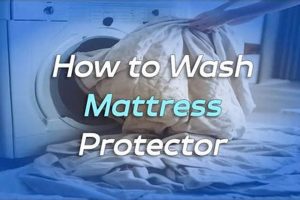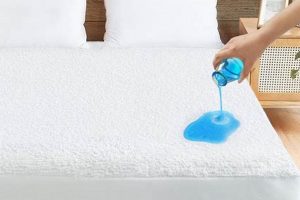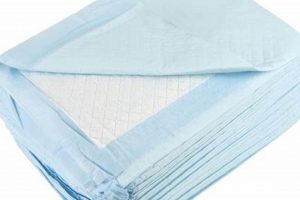This bedding component serves as a protective barrier for mattresses, shielding them from liquids and potential allergens. Constructed from materials designed to prevent the passage of moisture, it safeguards the underlying mattress core from stains, spills, and potential damage caused by incontinence or accidental fluid exposure. These items are often manufactured with a focus on minimizing potentially harmful substances in their composition.
The use of such protectors extends the lifespan of mattresses by preventing the build-up of moisture which can lead to mold and bacterial growth. Selecting options free from harmful chemicals promotes healthier sleep environments by reducing exposure to volatile organic compounds (VOCs) and other irritants. Historically, these items were less prevalent, with traditional mattress protection relying on thicker fabrics and less effective barriers. Modern iterations prioritize both performance and material safety.
The subsequent sections will delve into the specific materials utilized in their construction, examine relevant certifications and standards, and provide guidance on selecting an appropriate product to meet individual needs and priorities.
Guidance on Selecting a Safe and Effective Mattress Barrier
The following points offer direction in choosing a mattress protector that prioritizes both health and waterproof functionality.
Tip 1: Material Composition Assessment: Scrutinize the material list. Seek options that prominently feature organic cotton, bamboo, or other naturally derived fibers as the primary surface material. Avoid products that list vinyl (PVC) or phthalates, as these are known to off-gas potentially harmful chemicals.
Tip 2: Certification Verification: Prioritize products holding certifications from reputable third-party organizations. Look for certifications such as OEKO-TEX Standard 100, GOTS (Global Organic Textile Standard), or CertiPUR-US. These certifications indicate that the product has been tested for harmful substances and meets specific safety criteria.
Tip 3: Waterproofing Technology Examination: Understand the waterproofing mechanism. Polyurethane (PU) is a commonly used waterproof layer, but it should ideally be a thin, breathable layer. Consider alternatives like TPU (Thermoplastic Polyurethane) which is generally considered a safer option than PVC.
Tip 4: Breathability Considerations: Adequate breathability prevents moisture build-up and promotes a comfortable sleep environment. Evaluate the product description for mentions of breathability or airflow features. Mattress protectors lacking breathability can lead to overheating and discomfort.
Tip 5: Allergen Barrier Properties: Inquire about allergen barrier capabilities. A tightly woven fabric can prevent dust mites and other allergens from penetrating the mattress. This is particularly beneficial for individuals with allergies or asthma.
Tip 6: Washing and Care Instructions Review: Examine the care instructions. Opt for machine-washable options for ease of maintenance and hygiene. Frequent washing helps remove dust mites and other allergens.
Tip 7: Seam Construction Evaluation: Assess the seam construction quality. Secure, well-stitched seams contribute to the product’s durability and prevent liquid leakage. Poorly constructed seams can compromise the protector’s effectiveness.
Selecting a suitable mattress barrier requires careful consideration of materials, certifications, and design features. Focusing on these aspects will contribute to a healthier and more comfortable sleep environment.
The subsequent section will cover where to purchase suitable mattress protectors and common misconceptions.
1. Material Safety
Material safety constitutes a foundational element in the selection of a mattress protector designed to be free from toxic substances. The potential for off-gassing, allergenic reactions, and long-term chemical exposure necessitates a thorough understanding of the component materials. For instance, conventional mattress protectors often incorporate polyvinyl chloride (PVC) for its waterproof properties. However, PVC contains phthalates, known endocrine disruptors, and its production releases dioxins, persistent environmental pollutants. Consequently, the pursuit of a non-toxic alternative mandates the avoidance of PVC and similar materials.
Alternatives such as thermoplastic polyurethane (TPU) and polyethylene (PE) offer improved safety profiles, exhibiting reduced off-gassing and lacking the harmful additives associated with PVC. Natural materials like organic cotton, when combined with a breathable waterproof membrane, provide a viable solution. Certifications from organizations like OEKO-TEX and GOTS serve as verification that the product has undergone testing for a range of harmful substances, providing consumers with an added layer of assurance. The selection of materials, therefore, dictates the extent to which a mattress protector aligns with non-toxic principles.
In conclusion, material safety directly impacts the overall toxicity of a mattress protector. Prioritizing materials with established safety records and third-party certifications is paramount. While challenges may exist in balancing waterproof functionality with material safety, informed consumer choices contribute to a market shift towards safer and more sustainable products.
2. Waterproof Performance
Waterproof performance constitutes a critical attribute of any mattress protector intended to safeguard against liquid damage. Within the context of a product marketed as “non-toxic,” the waterproofing capability must be achieved without compromising material safety or introducing harmful chemicals. The causal relationship is direct: effective waterproofing prevents liquids from penetrating the mattress core, thereby inhibiting mold growth, bacterial proliferation, and allergen accumulation. Without adequate waterproof performance, the mattress is susceptible to contamination, diminishing its lifespan and potentially posing health risks.
The selection of waterproofing agents presents a significant challenge in the development of mattress protectors adhering to non-toxic standards. Traditional methods often rely on PVC or polyurethane films treated with chemical additives to enhance their water resistance. These additives may leach into the sleeping environment, exposing individuals to volatile organic compounds (VOCs) and other potentially harmful substances. Alternative approaches involve the use of tightly woven fabrics combined with a thin, breathable membrane composed of materials like thermoplastic polyurethane (TPU) or polyethylene. These membranes offer a waterproof barrier while minimizing the risk of chemical off-gassing. Real-world examples demonstrate the efficacy of these alternatives in protecting mattresses from spills, incontinence, and other forms of liquid exposure. The practical significance lies in the ability to maintain a hygienic sleeping surface without compromising health or environmental considerations.
Ultimately, waterproof performance is inextricably linked to the overall safety and efficacy of a “non-toxic” mattress protector. The challenge lies in striking a balance between achieving robust liquid protection and minimizing the use of potentially harmful materials. By prioritizing innovative materials and manufacturing processes, it is possible to create products that effectively safeguard mattresses while promoting a healthier sleep environment. Consumer awareness and informed purchasing decisions play a crucial role in driving demand for safer and more sustainable bedding solutions.
3. Breathability
Breathability serves as a critical factor in the overall performance and suitability of a mattress protector, particularly within the context of non-toxic and waterproof design. The presence or absence of breathability directly influences the sleep environment by regulating temperature and humidity. The causal link is evident: impermeable materials, while effectively preventing liquid penetration, impede airflow, leading to heat retention and moisture accumulation. This creates an environment conducive to bacterial and mold growth within the mattress itself, undermining the intended protective function. Conversely, breathable mattress protectors facilitate air circulation, mitigating heat build-up and allowing moisture to evaporate, thereby maintaining a more hygienic and comfortable sleep surface.
The challenge lies in achieving waterproof functionality without sacrificing breathability. Traditional waterproof mattress protectors often utilize non-breathable plastic or vinyl layers, which, while effective barriers, create a hot and potentially clammy sleeping environment. Innovative designs incorporate breathable waterproof membranes, such as those made from Thermoplastic Polyurethane (TPU) laminated to natural fabrics like organic cotton or bamboo. These materials allow air to circulate while preventing liquids from passing through. For example, a mattress protector made with an organic cotton surface and a TPU membrane offers a balance of comfort, breathability, and waterproof protection. The practical significance of this is evident in reduced night sweats, improved sleep quality, and a decreased risk of allergen accumulation within the mattress.
In summary, breathability is not merely a comfort feature but a vital component of a non-toxic waterproof mattress protector. It directly impacts the hygiene, longevity, and overall quality of the sleep environment. The understanding of this connection facilitates informed purchasing decisions, enabling consumers to prioritize products that effectively combine waterproof protection with optimal breathability, thereby fostering a healthier and more restful sleep experience. The integration of breathable materials represents a key advancement in mattress protector technology, addressing the limitations of traditional designs and promoting a more sustainable and health-conscious approach to bedding protection.
4. Allergen Protection
The relevance of allergen protection in conjunction with non-toxic and waterproof mattress barriers is significant, addressing critical aspects of indoor air quality and sleep health. These protectors serve as a barrier against common allergens, thereby improving the sleep environment.
- Dust Mite Barrier
Dust mites, microscopic organisms thriving in mattresses, are a primary source of allergens. A tightly woven mattress protector fabric prevents dust mites and their waste products from penetrating the mattress. This barrier effectively reduces allergen exposure for individuals sensitive to dust mites, mitigating respiratory symptoms and allergic reactions. For example, protectors with pore sizes less than 10 microns are typically effective at blocking dust mites.
- Pet Dander Prevention
Households with pets contend with pet dander, a potent allergen. Non-toxic waterproof mattress protectors can significantly reduce pet dander accumulation in mattresses. By preventing dander from embedding within the mattress fibers, these protectors facilitate easier cleaning and removal of allergens. Regularly washing the protector further minimizes allergen levels, promoting a healthier sleep environment for pet owners.
- Mold and Mildew Resistance
Moisture accumulation within mattresses can lead to mold and mildew growth, both of which are significant allergen sources. A waterproof mattress protector, particularly one constructed with breathable materials, prevents moisture penetration, thereby inhibiting mold and mildew development. This is crucial in humid climates or for individuals prone to night sweats. Materials with antimicrobial properties can further enhance mold and mildew resistance.
- Pollen Barrier
Pollen, especially during seasonal allergy periods, can infiltrate indoor environments and accumulate in bedding. A mattress protector acts as a barrier, preventing pollen from settling deep within the mattress fibers. This reduces pollen exposure during sleep, alleviating allergy symptoms. Selecting a protector with a tightly sealed zipper further minimizes pollen infiltration. Regular washing of the protector is essential for removing accumulated pollen.
Integrating allergen protection into non-toxic waterproof mattress barriers directly enhances the health and comfort of the sleep environment. These protectors function as a multifaceted defense against common allergens, minimizing exposure and promoting improved respiratory health. The effectiveness of allergen protection relies on factors such as fabric weave, material composition, and proper maintenance, underscoring the importance of informed product selection.
5. Durability
Durability, referring to the lifespan and resistance to wear of a mattress protector, is a paramount consideration, particularly when integrated within the context of a non-toxic and waterproof design. A mattress protector’s longevity directly correlates with its cost-effectiveness and environmental impact, influencing its overall value proposition.
- Material Strength and Construction Integrity
The inherent strength of the materials and the quality of construction significantly determine the durability of a mattress protector. Higher-denier fabrics, reinforced seams, and robust lamination techniques contribute to a protector’s ability to withstand repeated use, washing, and general wear and tear. For example, a protector utilizing tightly woven organic cotton with reinforced edges and a TPU membrane is inherently more durable than one constructed from thinner, less resilient materials. Failures in material strength or construction integrity can lead to premature tearing, seam separation, and loss of waterproof capabilities.
- Resistance to Degradation from Cleaning
The capacity to withstand repeated cleaning cycles without significant degradation is a critical aspect of durability. Frequent washing is essential for maintaining hygiene and removing allergens; therefore, a durable protector must retain its structural integrity and waterproof properties after numerous washings. Protectors with inferior materials or construction may experience shrinkage, delamination of the waterproof membrane, or diminished waterproof effectiveness after only a few wash cycles. This directly impacts the product’s lifespan and necessitates more frequent replacements.
- Waterproof Membrane Integrity Over Time
The waterproof membrane is a functional core. The membrane must withstand exposure to body fluids, oils, and general use without compromising its barrier properties. Over time, some materials may become brittle, crack, or delaminate, leading to leaks and diminishing the protector’s effectiveness. High-quality materials and advanced lamination processes enhance the membrane’s resistance to degradation, prolonging the protector’s useful life. For instance, using TPU versus PVC will affect its flexibility to temperature changes, hence increasing its durability.
- Resistance to Pilling and Abrasion
The surface fabric of a mattress protector is susceptible to pilling (the formation of small balls of fabric) and abrasion from friction against bedding and body movement. A durable protector should exhibit a high resistance to these forms of wear, maintaining a smooth and comfortable surface over time. Fabrics with a tight weave and a smooth finish are less prone to pilling and abrasion. Additionally, reinforcement of high-wear areas, such as the corners and edges, can further enhance the protector’s resistance to damage.
In conclusion, the durability of a non-toxic waterproof mattress protector is a multifaceted attribute encompassing material strength, construction integrity, and resistance to degradation from cleaning, prolonged use, and environmental factors. Prioritizing durable materials and construction techniques ensures a longer product lifespan, reduces the need for frequent replacements, and minimizes environmental impact, ultimately enhancing the overall value proposition for consumers.
Frequently Asked Questions
The following questions address common inquiries regarding the selection, usage, and maintenance of mattress protectors designed to be both waterproof and free from harmful substances.
Question 1: What materials should be avoided in a non-toxic waterproof mattress protector?
Materials to avoid include polyvinyl chloride (PVC), phthalates, flame retardants (such as PBDEs), and polyurethane foams containing volatile organic compounds (VOCs). These substances have been linked to potential health concerns and may off-gas into the sleeping environment.
Question 2: What certifications indicate that a mattress protector is truly non-toxic?
Certifications to look for include OEKO-TEX Standard 100, GOTS (Global Organic Textile Standard) for organic materials, and CertiPUR-US for polyurethane foams (ensuring low VOC emissions). These certifications verify that the product has been tested for a range of harmful substances.
Question 3: How does a mattress protector achieve waterproof functionality without using harmful chemicals?
Waterproof functionality can be achieved through the use of tightly woven fabrics combined with a thin, breathable membrane made of materials like thermoplastic polyurethane (TPU) or polyethylene (PE). These membranes provide a barrier against liquids while minimizing the risk of chemical off-gassing.
Question 4: Does a waterproof mattress protector compromise breathability and comfort?
Traditional waterproof mattress protectors made from non-breathable materials can indeed compromise breathability. However, modern designs utilizing breathable waterproof membranes, such as TPU laminated to natural fabrics, allow for air circulation and moisture evaporation, mitigating heat build-up and enhancing comfort.
Question 5: How should a non-toxic waterproof mattress protector be cleaned and maintained?
Refer to the manufacturer’s care instructions. Generally, machine washing in cold or warm water with a mild, non-toxic detergent is recommended. Avoid using bleach or fabric softeners, as these can damage the waterproof membrane and introduce harmful chemicals. Tumble dry on low heat or line dry to prevent shrinkage and maintain the protector’s integrity.
Question 6: How often should a non-toxic waterproof mattress protector be replaced?
The lifespan of a mattress protector depends on the quality of materials, construction, and usage. Regularly inspect the protector for signs of wear and tear, such as tears, seam separation, or diminished waterproof capabilities. A high-quality protector should last for several years with proper care. Replace the protector if it shows signs of damage or if its waterproof functionality is compromised.
In summary, selecting a non-toxic waterproof mattress protector requires careful consideration of materials, certifications, and care instructions. Prioritizing breathable and durable options ensures a healthy and comfortable sleep environment while protecting the mattress from damage.
The subsequent section will delve into relevant resources and further reading on the topic of non-toxic bedding.
In Conclusion
The preceding discussion has illuminated the critical aspects of selecting a non toxic waterproof mattress protector. Emphasis has been placed on material safety, waterproof performance, breathability, allergen protection, and durability. The importance of scrutinizing product certifications and understanding the potential health implications of various materials cannot be overstated. A judicious selection process ensures a healthier sleep environment and extends the lifespan of the mattress.
Continued vigilance in material selection and a commitment to informed purchasing decisions remain crucial. The demand for safer bedding options will drive further innovation and refinement in mattress protector design and manufacturing. Prioritizing non-toxic solutions is a tangible step toward fostering a healthier lifestyle.



![Best Plastic Twin Mattress Protector [Guide] Now! Organic & Natural Mattress Buyer’s Guide: Non-Toxic Sleep Solutions Best Plastic Twin Mattress Protector [Guide] Now! | Organic & Natural Mattress Buyer’s Guide: Non-Toxic Sleep Solutions](https://mattressworldpa.com/wp-content/uploads/2025/07/th-2519-300x200.jpg)
![Is a Mattress Protector Worth It? [Need + Guide] Organic & Natural Mattress Buyer’s Guide: Non-Toxic Sleep Solutions Is a Mattress Protector Worth It? [Need + Guide] | Organic & Natural Mattress Buyer’s Guide: Non-Toxic Sleep Solutions](https://mattressworldpa.com/wp-content/uploads/2025/07/th-2518-300x200.jpg)
![Best Deep Mattress Protector [Guide] - Sleep Soundly! Organic & Natural Mattress Buyer’s Guide: Non-Toxic Sleep Solutions Best Deep Mattress Protector [Guide] - Sleep Soundly! | Organic & Natural Mattress Buyer’s Guide: Non-Toxic Sleep Solutions](https://mattressworldpa.com/wp-content/uploads/2025/07/th-2517-300x200.jpg)

